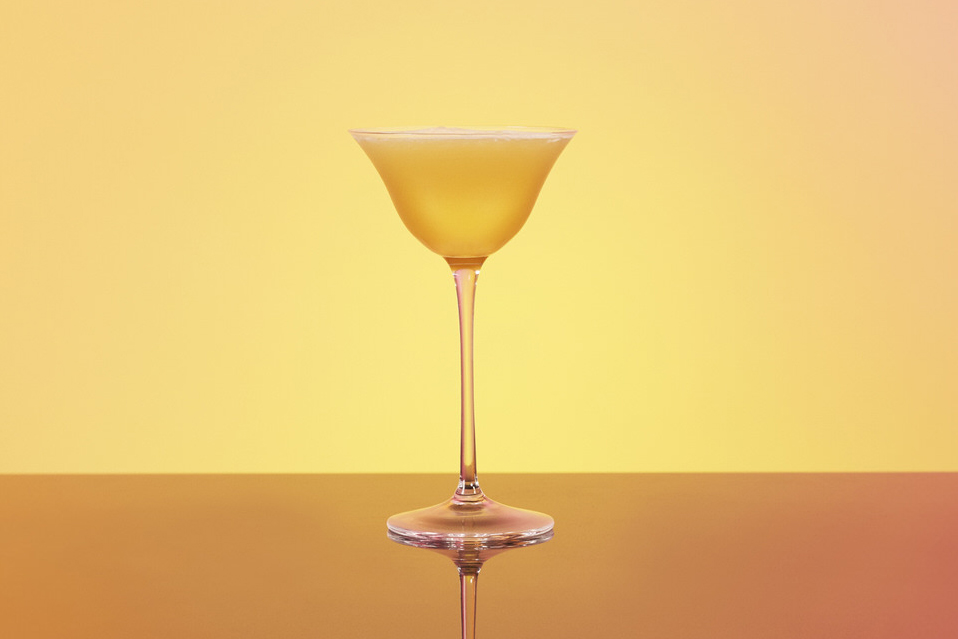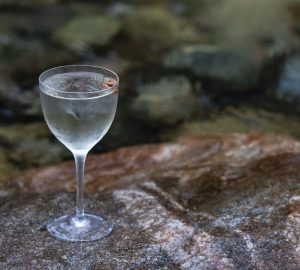Seamus Harris reports a wartime whimsy from the jazz age that became the basis for a whole family of drinks.
Panic filled the streets of Paris. World War One’s Spring Offensive of 1918 had broken the French lines and the Kaiser’s troops were reportedly mere hours away. Shells thudded incongruously into genteel boutiques as the German super-guns found range. Surrender looked inevitable, but perhaps there was faint hope in America’s late entry to the war. While the French fled, American soldiers streamed in to muster a last ditch defence. Could disaster be averted? And whichever way the winds of war blew, how long would the cognac last?
Seeking relief from the tension engulfing the city, an American officer ducked into a bar and requested an aperitif containing cognac for warmth and lemon for his dreadful head cold. These were peculiar times for bar owners. The American soldiers had the most uncultured tastes; cognac was traditionally an after-dinner drink. But the barman obliged with an improvised aperitif based on cognac, Cointreau and lemon juice. The American was delighted, the barman smugly satisfied, the drink a winner.
War is a confusing business even when sober, and it should come as no surprise that the above is but one version of events. Some eyewitnesses report that the officer actually sauntered into a café and ordered a leisurely meal followed by Crepes Suzette and cognac. Years of war had ravaged cognac stocks and the best on offer was decidedly inferior. Not much caring for the cognac, but not wanting to waste his drink, the officer impulsively took his dish of crepes and poured a little of the tangy orange liqueur sauce into his glass. The café hit on the idea of using this novel concoction to pacify rowdy American soldiers while divesting them of their pay. Très magnifique!
The American soldiers had the most uncultured tastes; cognac was traditionally an after-dinner drink. But the barman obliged with an improvised aperitif based on cognac, Cointreau and lemon juice
Truth be told, all that is known for certain is that on finishing his drink, the anonymous officer smacked his lips, buttoned his trench coat, and drove off in his sidecar. The roar of the engine faded, the rider vanished into the fog of war, and only controversy remained. Both Harry’s New York Bar and Le Petit Bar at the Ritz (now called the Hemingway Bar) in Paris claim the invention of the Sidecar, as did several famous bartenders of the 1920s. Perhaps the Sidecar is so named because it takes the drinker for quite a ride? No question that somebody has been taken for a ride over this one.
Forgetting its origins, the heyday of the Sidecar coincided with the Jazz Age and Prohibition. The disillusioned young American writers who frequented Paris in the 1920s adopted the drink, most notably Ernest Hemingway, F. Scott Fitzgerald and Henry Miller. Hemingway was naturally one of the more dedicated acolytes, regularly dispatching Sidecars from his favourite Parisian haunts, the Ritz and Harry’s New York Bar. Of the latter establishment, Hemingway would comment that “The only thing worth drinking is a Sidecar”. Coincidentally, in 1944, while reporting on the Second World War, Hemingway suffered a serious accident in which he was thrown from a sidecar into a ditch. One wonders whether his passion for Sidecars was a factor.
The Sidecar belongs to the New Orleans Sour cocktail family. These are spirit-based sours, sweetened with orange liqueur and served up. The original ancestor is the Brandy Crusta, a flamboyantly garnished and heavily sweetened cocktail from Antebellum New Orleans. The Sidecar was the first family member to gain lasting popularity though, perhaps because of its modernist way of stripping the idea to bare essentials.
Contemporary mainstays such as the Margarita and Cosmopolitan are straightforward Sidecar variations, as are neglected classics such as the White Lady. These are all natural crowd pleasers due to their easygoing sweet and sour profile, moderate tipsy-factor (compared to the aggressively boozy Martini or Manhattan), and stylish cocktail-glass aesthetic.
Timelessly classic yet sleekly modern, the Sidecar is just forgiving enough to make a handsome first vehicle for the learner drinker. For the more adventurous, it provides the perfect springboard for experimentation. For everyone, the classic brandy cocktail, the Sidecar is well worth taking for a spin.
From Paris to the Present: Some Pit Stops on the Sidecar’s Journey
1850sThe earliest ancestor of the Sidecar is born when Joseph Santini, manager of the bar at the New Orleans City Exchange, invents the Brandy Crusta. More elaborate than the Sidecar, Santini’s invention combined brandy, orange liqueur, sugar syrup, lemon juice and bitters – garnished with a sugared rim and the rind of half a lemon.
1862Jerry Thomas’ Bartenders Guide, the bible of 19th Century bartending, records the recipe for Santini’s Brandy Crusta. Variations such as Gin and Whiskey Crustas are also listed.
1875The Cointreau Distillery launches its Cointreau Triple Sec. Cointreau remains the benchmark for triple sec, and is almost essential to a good Sidecar.
1870sAnother Sidecar-like drink appears in the Brandy Daisy, essentially a brandy sour sweetened with orange liqueur rather than sugar. The Daisy would have confused modern Sidecar drinkers though. The liqueur in the Daisy was not always orange, the sweetness was ramped up with extra sugar or fruit syrup, and a dash of soda water was added for fizz.
1914-1918The first Sidecar is allegedly served to an American officer in a Paris bar. Nobody is sure exactly how or where the drink was invented, though most agree it was a fortuitous accident.
1922The Sidecar recipe appears in print for the first time. Harry MacElhone, of Harry’s New York Bar fame, lists a recipe in Harry’s ABC of Mixing Cocktails. This Sidecar comprises equal parts of Cognac, Cointreau and lemon juice. Appearing the same year, Robert Vermeire’s Cocktails and How to Mix Them gives a similar recipe. The equal-parts formula comes to be labeled the “French school”. There is no sugared rim.
1930The Savoy Cocktail Book lists a modified Sidecar that uses two parts of Cognac to one each of Cointreau and lemon juice. The cognac-heavy 2:1:1 formula comes to be labeled the “English school”, and most modern Sidecars are variations of this.
1934History moves full circle as bartenders start adding a sugared rim to the Sidecar. This elegant flourish makes the drink increasingly resemble a stripped down version of the venerable Brandy Crusta.
1930sCreative individuals substitute other spirits for the brandy in the Sidecar, resulting in the birth of the Margarita (made with tequila and lime) and White Lady (made with gin). The basic Sidecar formula is solid enough to see these new drinks become classics, and the so-called New Orleans Sour family of cocktails grows.
1980sThe Sidecar keeps on reinventing itself, this time in the form of the Cosmopolitan. A pleasant vodka-fueled riff on the formula, with a splash of cranberry for colour, the Cosmopolitan takes the world by storm. The Cosmopolitan soon spawns the currant-accented Metropolitan. The possibilities are endless.
2000sGrowing interest in classic drinks and quality ingredients sees more drinkers hopping into a Sidecar, enticed by its simple but brilliant combination of quality Cognac or brandy, Cointreau, and freshly squeezed citrus.
How to make a Sidecar
We tend to think of cognac as something to be sipped and savoured. Therefore, when mixing with cognac it is important to let the taste of the spirit shine. A good Sidecar should be sufficiently generous in the cognac department to let the customer to taste the spirit’s characteristics. I recommend going much heavier with the cognac than the original “French school” formula suggests. Everything else is flexible, so feel free to tweak the ratio of liqueur to citrus to suit.
The sugared rim is optional in my book, though it never hurts to ask whoever is drinking the thing. Consider splitting the difference by sugaring only half the rim.
A final piece of advice. Never spoil good brandy with cheap triple sec. Use Cointreau or something of similar quality.
Ingredients:
60ml Cognac (VSOP or better) or other quality brandy 1
15ml Cointreau
15ml lemon juice
If you want a sugared rim, first prepare a cocktail glass by rubbing the rim with lemon juice and then dipping in fine sugar. Pouring sugar into an appropriately sized saucer will make this step easier. Although not always practical, it helps to sugar the glass rim several hours before making the drink. This gives the sugared rim a chance to dry and harden, reducing problems of sticky glasses and sugary carpet. Prepared glasses can be stored in the fridge or freezer.
Shake all ingredients over ice and double strain into chilled cocktail glass. Garnish with a lemon twist.








